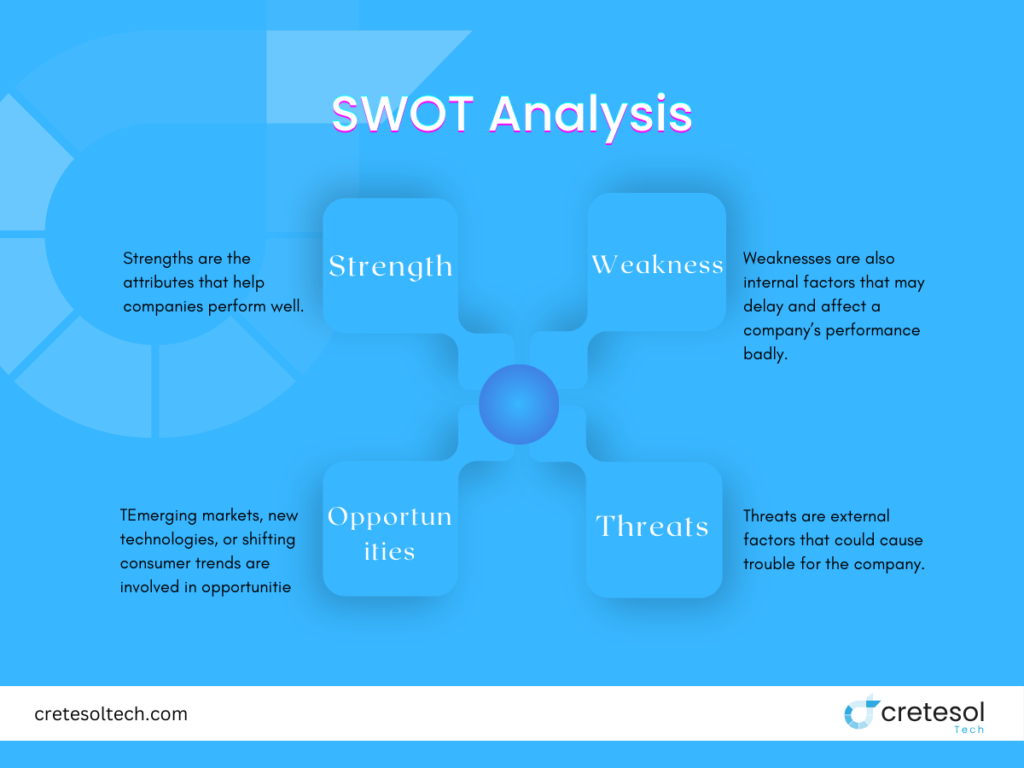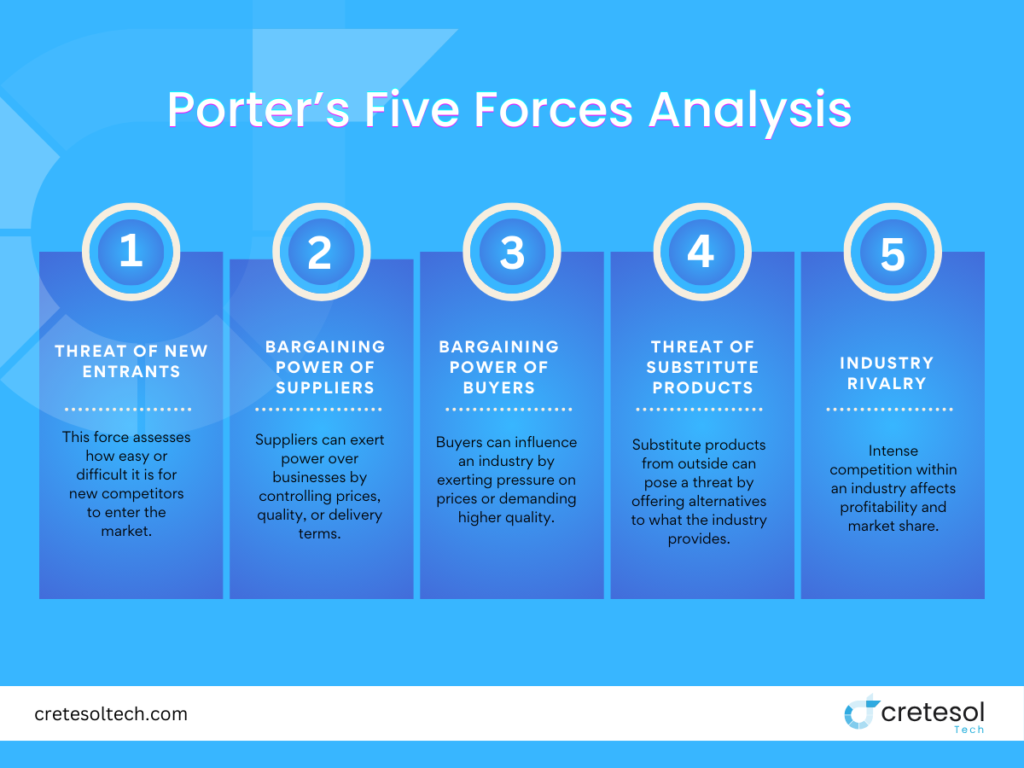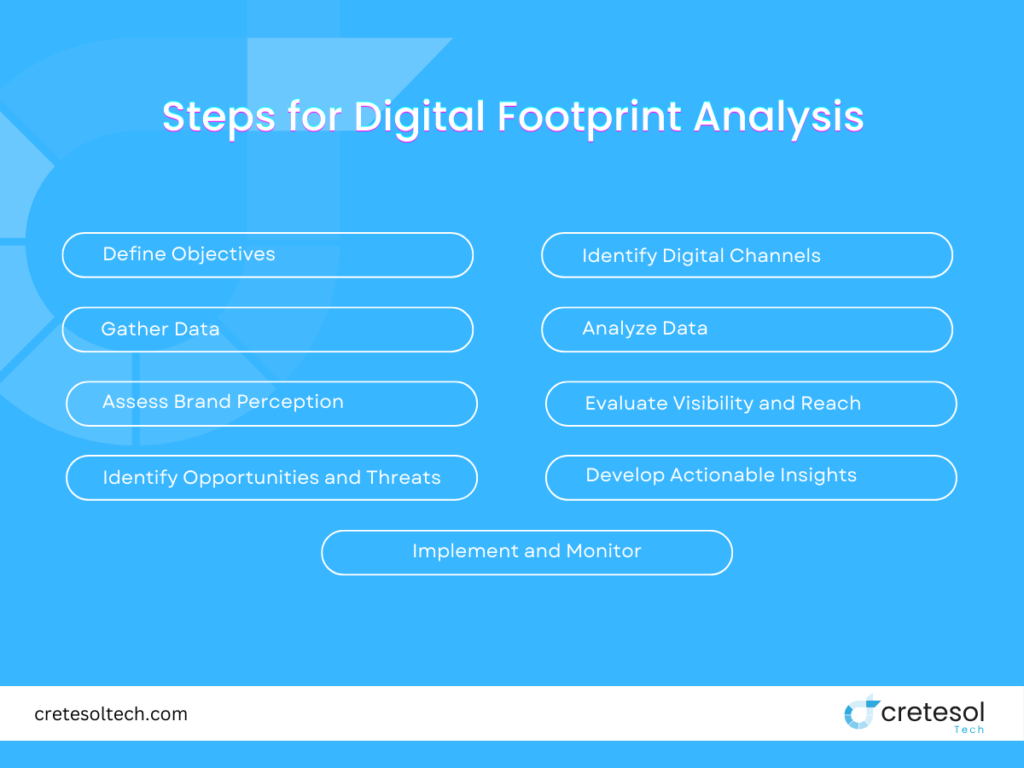Performing Competitive analysis in international markets and International market research processes is important for specific reasons. It helps you identify your differentiators. It allows you to highlight what sets your brand apart from the competition. It reveals competitors’ strengths. It shows you industry standards and areas where you need to improve. Competitor analysis enables you to set benchmarks for success. It guides your strategic planning and growth. Finally, it brings you closer to your target audience by helping you understand their preferences and needs. It allows you to tailor your products, services, and marketing strategies to meet their expectations effectively.
Here’s how you can compare your brand to those already succeeding and pave your path to market leadership.
- SWOT Analysis
- Porter’s Five Forces Analysis
- Benchmarking
- Digital Footprint Analysis
- Market Segmentation Analysis
SWOT Analysis

SWOT analysis helps understand the internal and external factors that affect a competitor’s performance. This strategic planning tool is valuable for identifying where competitors excel. This analysis finds out where they fall short, the opportunities they might seize, and the threats they might face.
| Strength | Strengths are the attributes that help companies perform well. It includes a strong brand reputation, a loyal customer base, and advanced technology. |
| Weakness | Weaknesses are also internal factors that may delay and affect a company’s performance badly. A company having bad image in the market might involve poor management, a weak brand, and high operating costs. |
| Opportunities | Emerging markets, new technologies, or shifting consumer trends are involved in opportunities. Opportunities are external factors and by using new opportunities companies can get a lot of advantages. |
| Threats | Threats are external factors that could cause trouble for the company. They might include new regulations, increased competition, or economic downturns. |
How to Start SWOT Analysis?
- Identify Competitors
- Gather Data
- Analyze Strengths
- Evaluate Weaknesses
- Spot Opportunities
- Assess Threats
To conduct competitor analysis using SWOT analysis in a global market, identify and list your competitors. Conduct thorough research to gather extensive data. Create a comparative table to assess each company’s strengths, noting key points to emulate in your strategy. Through this comparison, pinpoint why some companies excel in certain areas while others lag, identifying their weaknesses in the process.
Dont do the same mistakes they are making. Find out new opportunities and try to make your brand full of everything your competitors are lacking and also find out ways to improve your marketing. Try to make your marketing team aware of threats that your competitors are facing so that they will not affect you and your brand in the future.
10 key benefits of SWOT analysis:
- Strategic Planning: Provides a structured approach to strategic planning by assessing internal strengths and weaknesses, and external opportunities and threats.
- Holistic View: Offers a comprehensive view of the business environment, integrating both internal and external factors.
- Identification of Strengths: Helps identify core competencies, unique selling propositions, and areas of competitive advantage.
- Identification of Weaknesses: Highlights areas needing improvement such as operational inefficiencies, resource constraints, or outdated technology.
- Opportunity Recognition: Identifies market opportunities such as new trends, market gaps, or potential partnerships.
- Threat Awareness: Alerts businesses to external threats like competitive pressures, regulatory changes, or economic instability.
- Decision Support: Provides valuable insights to support decision-making processes across all levels of the organization.
- Resource Allocation: Guides efficient allocation of resources by focusing on areas of strength and opportunity.
- Risk Management: Facilitates proactive risk management strategies by addressing potential threats and vulnerabilities.
- Competitive Edge: Helps businesses gain a competitive edge by leveraging strengths, minimizing weaknesses, and capitalizing on opportunities in the market.
Porter’s Five Forces Analysis
Porter’s Five Forces analysis is a framework developed by Michael Porter to assess the competitive dynamics of an industry. It helps businesses understand the forces at play that influence profitability and competitive intensity within their industry.

| Threat of New Entrants | This force assesses how easy or difficult it is for new competitors to enter the market. Factors such as barriers to entry (e.g., high capital requirements, economies of scale, regulatory approvals) can determine the threat level. |
| Bargaining Power of Suppliers | Suppliers can exert power over businesses by controlling prices, quality, or delivery terms. The higher the supplier power, the less favorable it is for businesses in terms of profitability and operational flexibility. |
| Bargaining Power of Buyers | Buyers (customers) can influence an industry by exerting pressure on prices, demanding higher quality, or switching easily between competitors. Businesses need to understand buyer power to adjust pricing and marketing strategies accordingly. |
| Threat of Substitute Products or Services | Substitute products or services from outside the industry can pose a threat by offering alternatives to what the industry provides. This force evaluates the availability and attractiveness of substitutes that could potentially lure customers away. |
| Industry Rivalry | Intense competition within an industry affects profitability and market share. Factors such as the number of competitors, market growth rate, differentiation among products, and Competitive analysis in international markets determine the level of rivalry. |
How to Conduct Porter’s Five Forces Analysis
- Identify the Industry: Define the specific industry or market segment you are analyzing.
- Gather Data: Collect relevant information on competitors, suppliers, customers, substitutes, and industry dynamics through market research, industry reports, and expert analysis.
- Apply Each Force: Assess each of Porter’s five forces by analyzing the factors influencing them and their impact on your business or industry.
- Evaluate Overall Attractiveness: Summarize findings to evaluate the overall attractiveness and profitability of the industry.
5 Benefits of Porter’s Five Forces Analysis for Competitive analysis in international markets
- Strategic Insights: Provides deep insights into the Competitive analysis in international market dynamics of an industry, helping businesses formulate effective strategies.
- Risk Assessment: Helps identify and assess risks such as competitive threats, supplier power, and market volatility.
- Resource Allocation: Guides resource allocation by focusing on areas where competitive pressures are highest or industry attractiveness is strongest.
- Competitive Positioning: Facilitates understanding of Competitive analysis in international markets positioning relative to industry rivals, suppliers, and buyers.
- Long-Term Planning: Supports long-term planning by anticipating industry shifts, potential threats, and opportunities for growth or diversification.
Benchmarking
Benchmarking is a strategic management tool used to compare the performance of processes, products, or services against best practices or industry leaders. It helps organizations identify areas for improvement and achieve superior performance by learning from others. We define the key performance indicators (KPIs) or metrics you want to benchmark, such as cost efficiency, customer satisfaction, or product quality. Choose companies or organizations recognized as industry leaders or best-in-class performers in your chosen metrics.
Collect data on how your benchmarking partners achieve their superior performance, using sources like performance reports, case studies, or direct collaboration. Analyze and compare your performance against the benchmarking partners to identify gaps and areas for improvement. Develop and implement strategies to close performance gaps and adopt best practices identified through benchmarking.
Steps for Conducting Benchmarking for Competitive analysis in international markets
- Define Objectives
- Identify Metrics
- Select Benchmarking Partners
- Gather Data
- Analyze and Compare Performance
- Identify Gaps and Opportunities
- Develop Improvement Strategies
- Implement Changes
- Monitor and Measure Progress
- Continuous Review and Adjustment
5 Benefits of Benchmarking
Benchmarking enables organizations to continuously improve their performance, innovate, and maintain leadership in their industry by learning from the best and adapting proven practices to their operations. Benchmarking offers several benefits to organizations looking to enhance their competitive advantage and operational efficiency:
- Performance Improvement: Identifies specific areas where performance can be improved based on industry best practices.
- Competitive Insights: Provides insights into how industry leaders achieve superior performance, helping organizations stay competitive.
- Innovation: Promotes innovation by adopting new ideas, technologies, or processes from benchmarking partners.
- Strategic Planning: Guides strategic planning by setting realistic goals and targets based on industry standards and best practices.
- Customer Satisfaction: Improves customer satisfaction by aligning processes and services with industry benchmarks for quality and efficiency.
Digital Footprint Analysis
Digital footprint analysis involves the systematic examination of an individual’s, organization’s, or brand’s online presence across various digital platforms and channels. This analysis aims to gather insights into how they are perceived, their impact, and their visibility in the digital landscape.
Digital footprint analysis refers to the process of examining and evaluating the online presence and activities associated with an individual, organization, or brand. It involves gathering and analyzing data from various digital sources to understand how they are perceived, their impact, and their visibility in the digital landscape.
Steps for Digital Footprint Analysis
- Define Objectives
- Identify Digital Channels
- Gather Data
- Analyze Data
- Assess Brand Perception
- Evaluate Visibility and Reach
- Identify Opportunities and Threats
- Develop Actionable Insights
- Implement and Monitor

Components of Digital Footprint Analysis for Competitive analysis in international markets
| Data Collection | Sources: Collect data from diverse digital sources such as websites, social media platforms (e.g., Facebook, Twitter, LinkedIn), review sites (e.g., Yelp, Google Reviews), forums, blogs, and news articles. | Types of Data: Gather information including website traffic, social media engagement metrics (likes, shares, comments), online reviews and ratings, mentions, press coverage, and customer feedback. |
| Analysis and Evaluation | Sentiment Analysis: Assess the sentiment associated with the digital footprint to gauge overall perception of positive, negative, or neutral sentiments. | Performance Metrics: Analyze key performance indicators (KPIs) like reach, engagement rates, conversion rates, and brand mentions to measure effectiveness and impact. |
| Audience Insights | Demographics: Identify audience demographics (age, gender, location) and behaviors (interests, online activities) to tailor marketing strategies and improve targeting. | Customer Journey: Track and analyze the customer journey from initial awareness to conversion to optimize digital marketing campaigns and improve user experience. |
| Opportunities and Threats | Opportunities: Discover growth opportunities such as emerging trends, new market segments, or untapped digital channels. | Threats: Identify risks such as negative reviews, social media crises, cybersecurity vulnerabilities, or competitive threats. |
| Strategic Recommendations | Actionable Insights: Derive actionable insights and recommendations based on the analysis to enhance online reputation, increase engagement, optimize digital marketing efforts, and mitigate risks. | Strategic Planning: Inform strategic planning and decision-making processes by leveraging data-driven insights and trends uncovered through the analysis. |
Benefits of Digital Footprint Analysis
- Enhanced Visibility: Improves online visibility and strengthens brand presence across digital channels.
- Reputation Management: Helps manage and enhance brand reputation by addressing issues promptly and leveraging positive feedback.
- Competitive Advantage: Provides Competitive analysis in international markets insights and benchmarks against industry peers to identify areas for improvement and innovation.
- Audience Understanding: Deepens understanding of target audience preferences, behaviors, and sentiments to tailor marketing strategies effectively.
- Risk Mitigation: Identifies potential risks and threats early, allowing proactive measures to mitigate risks and safeguard brand reputation.
Market segmentation analysis
Market segmentation analysis is a strategic process of dividing a broad consumer or business market, normally consisting of existing and potential customers, into sub-groups of consumers (known as segments) based on some type of shared characteristics. These segments are then used to tailor marketing strategies and offerings to better meet the needs and preferences of each segment.
Market segmentation analysis involves several key steps to effectively understand and target specific consumer segments:
How to do Market Segmentation Analysis
- Define Objectives
- Set international market segmentation and positioning Criteria
- Data Collection
- Segmentation Analysis
- Profile Segments
- Evaluate Segment Attractiveness
- Targeting Strategy
- Positioning Strategy
7 Benefits of Market Segmentation Analysis
Market segmentation analysis provides several benefits to businesses looking to effectively target and serve distinct customer segments:
- Enhanced Customer Understanding: Gain deeper insights into customer needs, preferences, and behaviors within each segment.
- Targeted Marketing Strategies: Tailor marketing messages, campaigns, and promotions to resonate with specific segments, increasing relevance and effectiveness.
- Improved Product Development: Design products or services that meet the specific requirements and desires of targeted segments, leading to higher customer satisfaction and loyalty.
- Optimized Resource Allocation: Allocate resources (time, money, manpower) more efficiently by focusing on segments that offer the greatest potential for return on investment.
- Competitive Advantage: Differentiate your offerings from competitors by addressing niche markets or underserved segments with specialized products or services.
- Increased Sales and Profitability: Drive sales growth and profitability by effectively meeting the needs of diverse customer segments and maximizing market penetration.
- Risk Mitigation: Reduce risks associated with market fluctuations or changes in Consumer insights for international markets and behavior by diversifying customer base across multiple segments.
Key factors commonly used in market segmentation analysis for Competitive analysis in international markets:
| Demographic Segmentation | Psychographic Segmentation | Behavioral Segmentation | Geographic Segmentation | Technographic Segmentation | Ethnographic Segmentation | B2B Segmentation Factors |
| Age: Dividing the market by age groups (e.g., teenagers, young adults, middle-aged). | Lifestyle: Dividing based on lifestyles, interests, and activities (e.g., outdoor enthusiasts, health-conscious). | Usage Rate: Dividing based on the frequency of product usage (e.g., heavy users, occasional users). | Region: Dividing by geographic location, such as country, state, city, or rural vs. urban areas. | Digital Behavior: Dividing based on technology usage, online behaviors, and preferences (e.g., social media usage, online shopping habits). | Cultural Factors: Segmenting based on cultural background, customs, traditions, and values. | Industry: Dividing business customers by industry sector (e.g., healthcare, finance, retail). |
| Gender: Segmenting based on gender (e.g., male, female, non-binary). | Values and Beliefs: Segmenting by values, beliefs, and attitudes towards products or brands (e.g., environmentally conscious consumers). | Brand Loyalty: Segmenting by loyalty levels towards a brand (e.g., loyal customers, switchers). | Climate: Segmenting based on climate conditions and their influence on product preferences or needs. | Device Usage: Segmenting based on types of devices used (e.g., mobile users, desktop users). | Social Class: Grouping based on social class distinctions and associated behaviors and preferences. | Company Size: Segmenting based on company size (e.g., small businesses, large enterprises). |
| Income: Grouping consumers by income levels (e.g., low-income, middle-income, high-income). | Personality Traits: Segmenting based on personality traits and characteristics that influence purchasing decisions. | Purchase Behavior: Grouping based on purchasing habits and decision-making processes (e.g., impulse buyers, methodical buyers). | Buying Motivations: Grouping by reasons for purchasing, such as cost-saving, innovation, or reliability. | |||
| Education: Segmenting based on educational attainment (e.g., high school graduates, college graduates) |
Conclusion
Conducting competitor analysis in a global market is crucial for gaining strategic advantages. Strategies like SWOT analysis, Porter’s Five Forces Analysis, benchmarking, digital footprint analysis, and market segmentation analysis provide comprehensive insights. These methods illuminate internal strengths and weaknesses and reveal external opportunities and threats, guiding informed decision-making.
At Cretesoltech, we excel in leveraging these strategies to help businesses refine their strategies and enhance market positioning. We ensure our clients sustain a competitive edge in dynamic global environments by benchmarking against industry leaders, analyzing digital footprints, and segmenting markets effectively.
Faqs
What are the 5 steps to analyze your competitor?
Identify your competitors by listing major players in your industry. Gather information from various sources like websites and annual reports. Perform a SWOT analysis to understand strengths, weaknesses, opportunities, and threats. Benchmark your performance against competitors. Continuously monitor and update your analysis to stay informed about changes in the Competitive analysis in the international market landscape.
Which is a strategy for competitor analysis?
SWOT analysis is a strategic tool that evaluates internal strengths and weaknesses alongside external opportunities and threats. It helps businesses understand their competitive position and make informed decisions about strategy and resource allocation.
What are the 5 types of competitors in marketing?
Direct competitors offer similar products or services to the same target market. Indirect competitors provide alternative solutions using different technologies. Substitute competitors offer products that can replace or serve as alternatives to your offerings. Potential competitors are companies not currently in the market but could enter in the future. International competitors operate globally and compete with local or multinational companies in various markets.

 United Arab Emirates
United Arab Emirates